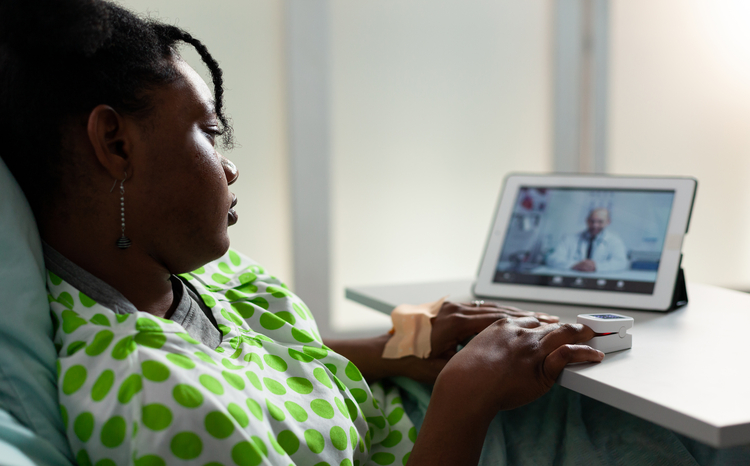Could virtual hospitals be the solution to the broken NHS?
- 28 November 2024

Wider development and roll out of virtual hospitals could move us away from trust silos, easing regional variations to create a transformed national service, writes Paul Grant digital health consultant and the author of The Virtual Hospital.
A ‘virtual hospital’ is a concept that combines digital technologies along with a reconsideration of the way that healthcare services are operated. It allows the creation of new and alternative pathways of care, many of which are remote and asynchronous. Unlike a traditional hospital where patients are admitted and treated on-site, a virtual hospital works primarily through virtual platforms, such as telemedicine and online dashboards, using digital communication tools.
In a virtual hospital, healthcare professionals can remotely assess, diagnose, treat and monitor patients through a variety of digital means. This may include the roll out of clinical command centres, greater use of virtual wards in which patients are managed remotely whilst still in their own home, and virtual out-patient services through organisations such as Medefer which has a network of remote specialists across the UK.
There are even virtual emergency departments which have been shown to work successfully in places such as Ontario in Canada, which can efficiently triage and navigate patients using digitised processes. All these approaches have the goal of reducing the burden on physical health systems and improving convenience and accessibility for patients.
Low thresholds for risk
Are they safe? Whilst existing bricks and mortar hospitals and healthcare facilities continue to have high rates of significant events and medical errors, any new system of care delivery, especially one in which the patient and the clinician are not co-located, needs to be robust and mindful of clinical risk and governance.
Are the right patients being selected for remote monitoring? Can the clinician adequately assess an individual over the internet? And is there potential for damage to the doctor-patient relationship if the throughput of large numbers of patients in a transactional online process erodes the human, caring aspects of medicine?
Clinical safety standards need to be built in with care and consideration
The answers to these questions will all come down to set up, design and iteration. Clinical safety and regulatory standards need to be built in with care and consideration. It is likely that low thresholds will be in place for reverting to care in physical setting, with automated processes and data analytics to help identify when patients fall into more risky categories.
Will they be cost-effective? Keeping people in a hospital bed is an expensive business so the belief is that avoiding hospital admissions, limiting A&E attendances, or reducing length of stay will ultimately save costs. There are already several cost-benefit analyses that suggest positive impacts due to lower overhead and staffing costs when compared with a traditional in-patient or out-patient journey. Virtual hospitals can help to reduce waiting times for those that need to be seen face to face. They also provide an opportunity to develop economies when scaling across wider regions that may have been previously underserved or stretched.
Digital exclusion and inequality are key considerations and impact people who lack access to technology and those who lack digital literacy. There are also issues with language, cultural barriers and accessibility that need to be overcome. The consumer digital index shows that 11.9 million people (22% of the population) do not have the digital skills needed for everyday life in the UK; by 2030 it is predicted that 4.5 million people will remain digitally disengaged. Fixing the fundamentals of digital exclusion is therefore very important for the health service.
There are already successful trials of schemes offering skills training and confidence building and the loan of internet enabled devices. The co-creation of digital solutions with target populations and the wider roll out of digital maturity assessment for legacy healthcare providers [can also help tackle digital exclusion and inequality].
Realise the potential
The promise of virtual hospitals is aligned with the government plans to utilise more technology, to shift care into community settings, and place greater emphasis on preventative care. Along with a technology ready workforce, virtual hospitals can utilise remote monitoring technologies, population health management dashboards, clinical decision support tools, greater use of genomics and AI. All play a part in identifying at risk patients and facilitating early and ongoing interventions for a wide variety of medical problems.
A national virtual hospital would be a way of bringing about true clinical-digital transformation
A digital approach also affords a prime opportunity to nationalise the NHS. This means taking a whole systems approach, using data collection and analysis to share workloads and workforce, better distribute resources, overcome duplication, and performance manage care delivery. [Such an approach could] overcome the major regional variations in care that the country currently experiences.
Think of the palletised distribution network used by freight companies collectively working together as a foundational model of a national virtual hospital running multiple services within a digital first, coordinated approach. This would move us away from trust island siloes and NHS managerialism. It would be a way of bringing about true clinical-digital transformation.





